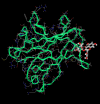Exploring the Potential of a Novel Oil Blend Therapy for Immunity Enhancement and Cervical Carcinoma Treatment
- PMID: 40542775
- PMCID: PMC12374503
- DOI: 10.31557/APJCP.2025.26.6.2129
Exploring the Potential of a Novel Oil Blend Therapy for Immunity Enhancement and Cervical Carcinoma Treatment
Abstract
Objective: To evaluate the therapeutic potential of a novel vegetable oil blend containing natural bioactive compounds for the treatment of cervical carcinoma through in silico molecular docking analysis.
Methods: Natural compounds were extracted from cold-pressed pumpkin oil (Curcubita maxima), horsetail oil (Equisetum arvense), and etheric clove oil (Syzygium aromaticum). Major phytochemicals quercetin 3-O-glucoside, γ-tocopherol, apigenin 5-O-glucoside, β-caryophyllene, kaempferol 3-O-glycoside, and EGCG were identified and standardized via HPLC. Molecular docking was performed using 1-Click Docking software to assess binding affinities against cervical carcinoma-associated targets (p16INK4a, Ki-67, VEGF, CEA, MMP-9, TP53, and pRb). Docking scores were expressed as Gibbs free energy (ΔG, Kcal/mol). Comparative analyses were conducted versus conventional agents (Paclitaxel, Pembrolizumab, Temsirolimus). AI-assisted optimization using ChatGPT-4o integrated molecular interaction data from over 10,000 peer-reviewed studies.
Results: Apigenin 5-O-glucoside showed the strongest interaction with MMP-9 (-11.6 Kcal/mol) and CEA (-9.4 Kcal/mol). Quercetin 3-O-glucoside exhibited high affinity for TP53 (-8.1 Kcal/mol), Ki-67 (-9.1 Kcal/mol), and VEGF (-8.7 Kcal/mol). Natural compounds consistently outperformed standard chemotherapeutics, e.g., Paclitaxel with p16INK4a (-5.4 Kcal/mol) vs. apigenin 5-O-glucoside (-8.9 Kcal/mol). These results suggest robust multi-targeted anticancer potential, including inhibition of proliferation, angiogenesis, and metastasis, along with apoptosis induction.
Conclusion: Natural compounds derived from a novel vegetable oil blend demonstrate promising molecular interactions with key biomarkers of cervical carcinoma. These findings support their potential role as effective therapeutic agents and warrant further in vitro and in vivo validation.
Keywords: Molecular docking; Therapeutic Biomarkers; Vegetable Oil Blend; cervical carcinoma; natural compounds.
Conflict of interest statement
The authors declare that there are no conflicts of interest financial or otherwise that may have influenced the design, execution, or reporting of this study.
Figures







References
-
- Dunne EF, Park IU. HPV and HPV-associated diseases. Infect Dis Clin North Am. 2013;27(4):765–78. - PubMed
-
- Tran NP, Hung CF, Roden R, Wu TC. Control of HPV infection and related cancer through vaccination. In: Dittmer DP, Damania B, editors. Viruses and Human Cancer. Recent Results Cancer Res. Vol. 193. 2014. pp. 149–71. - PubMed
-
- Franco EL. Viral etiology of cervical cancer: a critique of the evidence. Rev Infect Dis. 1991;13(6):1195–206. - PubMed
-
- Bornstein J, Rahat MA, Abramovici H. Etiology of cervical cancer: current concepts. Obstet Gynecol Surv. 1995;50(2):146–54. - PubMed
MeSH terms
Substances
LinkOut - more resources
Full Text Sources
Medical
Research Materials
Miscellaneous

